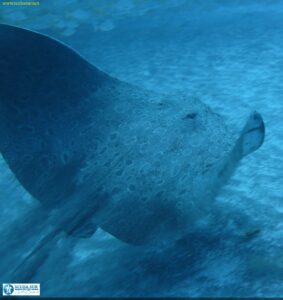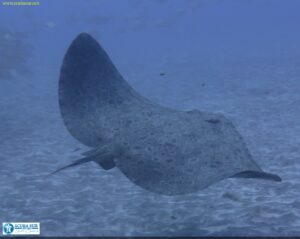Be surprised by the spiny butterfly ray
A passing butterfly ray, with a span of sometimes more than 2 m, does not stay unnoticed. You do admire the apparently effortless movements that make it glide beautifully through the water. It is just spectacular!

- How to recognize a spiny butterfly ray?
- Scuba Diving
- The spiny butterfly ray diet
- Reproduction
- Good to know
- Some Science
- More Information
How to recognize a spiny butterfly ray?
The ray has a diamond-shaped body which is much wider than it is long. The corners of the body are rounded. Its snout is short and blunt. The butterfly ray has a very short tail, which measures about a quarter of its body. The skin is dark brown above, sometimes with small lighter or darker spots and blotches in a marbled pattern, and white below. The official maximum size is about 2.2m, but unofficial reports exists where butterfly rays were spotted of over 4m. The maximum published weight is 60 kg.
Scuba Diving
When diving in the south of Gran Canaria, always look out for the imprints in the sandy bottom, indicating the presence of the spiny butterfly ray. These rays are harmless to humans, though if stepped on its tail spine can cause a painful wound.

The spiny butterfly ray diet
The spiny butterfly ray mainly feeds on fishes and squids. An active predator, the ray typically approaches a prey item slowly before rapidly spinning around over it and striking the food with the leading edge of one of their pectoral fins. This behaviour likely serves to stun the prey before capture, as they contain a high proportion of red muscle and can deliver blows of substantial force.
On the other side, it serves as pray for the larger fish such as the great hammerhead and marine mammals. With the shark population under pressure, it is expected their population will increase. Nevertheless many rays die as bycatch in the nets of commercial fishing operations.
Reproduction
Spiny butterfly rays give birth to live young. They have an annual reproductive cycle with a gestation period of 4 to 9 months. The embryos initially subsist on a yolk sac; later in development long villi develop from the uterine wall into the embryos’ spiracles, which direct uterine milk into the oral cavity. Litter size is up to 8.
Good to know
The spiny butterfly ray has about 200 teeth….
Some Science
| Kingdom | Animalia |
| Phylum | Chordata |
| Class | Chondrichthyes |
| Order | Myliobatiformes |
| Family | Gymnuridae |
| Genus | Gymnura |
| Species | Gymnura altavela |
More Information
We get many questions about what there is to see when you go diving in the south of Gran Canaria. We want to respond to this by creating a number of articles where each highlights a specific species we regularly encounter when diving in the Atlantic. The complete series gives you a good idea of what to find when scuba diving in the blue waters of the south of Gran Canaria. Let’s be clear we are not marine biologists; just a dive centre trying to provide valuable information to our customers.
For the full details of the species we would like to refer to www.Wikipedia.com. Here you’ll find more detail than we go into.




